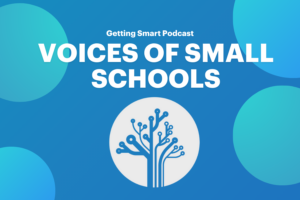Better Formative Feedback: Work Worth Doing in a Place Worth Being

By Mary Ryerse & Tom Vander Ark
Everything about school provides some sort of formative feedback to students.
By formative, we mean “shaping or molding.” Indeed, everything about a learning environment shapes and molds the overall student experience.
The culture makes it clear that all lives matter and that all opinions matter–or not. The goals embrace high expectations for all learners–or not. The structures are inclusive and equity promoting–or not.
Where the school is located, what it looks like, how students get there all speak loudly to what is important to a community. The adults at school and the extent to which they embrace and look like the community of learners speaks to priorities.
The nature of learning experiences–short, narrow, and thin or extended, integrated and deep–signal what is important. Work focused on compliance and completion kills motivation. Work that inspires a culture of possibility around public products encourages a culture of revision (and all that growth mindset stuff).
Want your students to do excellent work? You can’t just improve formative assessment–everything is formative. Make sure everything–structures, policies, practices and, most of all, learning experiences–says “excellent work is done here.”
While everything about a learning environment may provide formative feedback to students, not everything qualifies as formative assessment.
Defining Formative Assessment
Overall, we’ve done a good job helping students “learn how to learn.” One of the biggest growth opportunities today is to help teachers and students to “know how they know.” Educators skilled at designing formative assessment practice are able to understand where students are and where they need to be on a daily basis and adapt learning experiences accordingly.
The Council of Chief State School Officers (CCSSO) recently adopted the following definition of formative assessment:
Formative assessment is a planned, ongoing process used by all students and teachers during learning and teaching to elicit and use evidence of student learning to improve student understanding of intended disciplinary learning outcomes, and support students to become more self-directed learners.
~ CCSSO FAST SCASS Austin, Texas, June 2017
The complete CCSSO definition goes on to describe the importance of providing clear learning targets, eliciting evidence of learning, engaging in self-assessment–and ultimately, using evidence to move learning forward.
This definition was generated through the work of CCSSO’s Formative Assessment for Students and Teachers State Collaborative on Assessment and Student Standards (FAST SCASS). The group has been leading the way for over 15 years.
The updates to this definition emphasize a couple of things over the 2006 definition:
- Increased student role: Emphasis on the role of the students themselves, which aligns beautifully with an emphasis on SEL, self-awareness and self-management (all key to learning today).
- Standards focused: The specific reference to ensuring that all students understand “intended disciplinary learning outcomes” grounds the work in standards.
When implemented effectively, formative assessment is not an isolated event but rather a regular and integral part of the classroom routine, as well as all the formal and informal feedback students receive (or perceive) in the course of their studies.
What We Know About Current Formative Assessment Practice
In 2015, the Michael & Susan Dell Foundation sponsored work with teachers in the Austin, Denver and Metro Nashville school districts to learn how (and how well) teachers in these districts use data to inform instruction on a daily basis. Data was gathered from this project and detailed in Formative Assessment in the Classroom, published in May of 2016. Key findings include:
- Uneven practice. Teachers regularly use some type of formative assessment strategies, but the implementation of their practice is uneven. In general, teachers need more support and practice to improve effectiveness. This is particularly true in important areas such as inviting student participation and ownership of learning. One example is frequency–most teachers typically engage in formative assessment practice on a weekly basis when ideally they would do so on a daily basis by integrating formative assessment into regular classroom teaching and learning routines.
- Insufficient support. Teachers report that the support provided by districts for formative assessment is insufficient and that they most often turn to their colleagues for support to improve their formative assessment strategies. While all of the involved districts provided some form of support for formative assessment practice, there was not always agreement regarding definition or priority for ongoing support.
- Barriers to implementation. Significant barriers to implementing effective formative assessment practice still exist. The barriers cited–including, but not limited to time, training and resources–reflect common structural, technical and attitudinal changes when making and fundamental shift in instructional practice
- Relationship to use of technology. Teachers who used formative assessment practices more frequently also reported more use of technology, especially if they had school or district support. While overall technology usage by teachers across the study districts was consistently low, there was a correlation in usage. In order to effectively use technology for formative assessment, teachers need to have a working knowledge of formative assessment.
The study also shows teachers are optimistic about their abilities to understand and use formative assessment in the classroom, believe their curriculum supports formative assessment and individualized instruction, and feel they have administrative support to incorporate formative assessment into their teaching practice.
Creating Places Where Excellence is Done: Work Worth Doing
Students in some blended schools get a lot of embedded feedback but they just traded paper worksheets for digital worksheets. Some schools get so focused on combining formative data streams they forget about the learning experience. Want to provide better feedback? Start with providing authentic work worth doing and then work to design effective formative assessment practice within that context.
It’s hard to create places where all learners–young and old– do excellent quality work. Where we’ve seen high school students do professional quality work, it is a result of:
- High expectations: Starting with a picture of quality like EL’s Models of Excellence or a tradition of great publications like High Tech High or Palo Alto High journalism
- Public products: Moving beyond “turn it in” to publish it or present it to a client.
- Honest feedback: Students at One Stone (in the Boise high school and after school program) receive feedback from coaches (teachers), mentors, peers and clients.
- A culture of revision: At One Stone, students know it make take more than 50 tries to get a great idea or a quality product (the call it “51ing it”).
- Strong real time support: If you want high quality, you have to support it with strong supports–there are several ways to get real time help.
- Supportive culture: Students may not take tough feedback well if they don’t know you care not only about the work but about them.
Being aware of what provides formative feedback to students won’t boost achievement by itself. Skilled formative assessment practice is critical. It starts with work worth doing, in a place worth being, with people who care.
For more, see:
- Supporting English Language Learners with Formative Assessments
- Embedded Formative Assessment: Tests without Stress
- Should Teachers Share Formative Assessment Results in the Classroom?
Stay in-the-know with all things EdTech and innovations in learning by signing up to receive the weekly Smart Update.






0 Comments
Leave a Comment
Your email address will not be published. All fields are required.